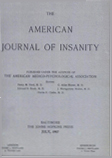FURTHER REPORT ON NURSES' CONDUCT SCHEME
Abstract
This nurses' conduct scheme has continued in successful operation for the year. It has been successful fundamentally because it challenges the nurses' cooperation in the research work of the hospital. It has been favorably accepted elsewhere, though on a much smaller, scale than that which we are carrying out here.
This scheme represents an attempt at a mathematical evaluation of the clinical condition of the patient and were there the space to publish all of the charts we could establish our contention—that even in its present crude form, this scheme gives a picture more accurate and more helpful than any hitherto made of the clinical progress of psychotic cases. As a clinical correlate for recurrent laboratory procedures some such scheme is a necessity and this scheme represents, to date, at least a hopeful answer to this need.
Such a scheme must have a rational basis. Our own method of meeting this requirement has been described, partly as a history of its progress and partly as some sort of a map for the future construction of such rating schemes.
We have challenged, on the basis of results, the unquestioned acceptance of Binet's doctrine of sampling.
There are now something over 70,000 entries. It seems that this represents, at least in these early states of the scheme, a sufficient amount of data on which to go ahead.
Again I must make my acknowledgments to the nurses of McLean Hospital. Theirs has been a loyalty and interest without which we could never have hoped to embark upon this experimental phase of the scheme. Without their cooperation and helpful criticism we could have gotten nowhere. Again, my wife, through suggestions and constant assistance has assured the progress of the present year.
Access content
To read the fulltext, please use one of the options below to sign in or purchase access.- Personal login
- Institutional Login
- Sign in via OpenAthens
- Register for access
-
Please login/register if you wish to pair your device and check access availability.
Not a subscriber?
PsychiatryOnline subscription options offer access to the DSM-5 library, books, journals, CME, and patient resources. This all-in-one virtual library provides psychiatrists and mental health professionals with key resources for diagnosis, treatment, research, and professional development.
Need more help? PsychiatryOnline Customer Service may be reached by emailing [email protected] or by calling 800-368-5777 (in the U.S.) or 703-907-7322 (outside the U.S.).



